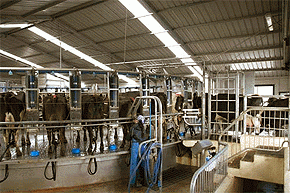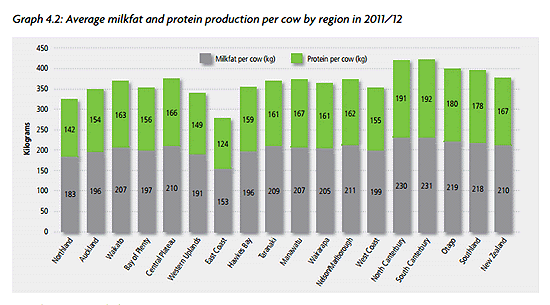
Last year’s dairy season will go down in history as the most productive on record thanks to very favourable pasture growth conditions, according to data released for the 2011-2012 season by Dairy NZ.
New Zealand’s milk production leaped 11.3%.
Average production per cow reached a new record of 364 kilograms of milksolids, and more cows being milked resulted in dairy companies processing 19.1 billion litres of milk containing 1.69 billion kilograms of milk solids in the year ending 31 May 2012.
Milk production per hectare of 1,028 kg surpassed the 1,000 kg mark for the first time.
The 2011-12 New Zealand Dairy Statistics report is made up of data sourced from the LIC National Database, dairy companies, Animal Evaluation database, Animal Health Board Annual Report, Real Estate Institute of NZ and Statistics New Zealand.
Other key statistics from 2011/2012 include:
Production
The milk production increase was the first double digit increase since 2000-01 and was due to a lift in milksolids production per cow (80%) and more cows milked (20%).
Production per cow increased by 9% to an average of 364 kg milksolids (comprising 206 kg milkfat and 158 kg protein).
Most regions recorded double digit increases in milksolids produced per hectare with the North Island averaging 12.0% and the South Island averaging 10.1%.

Breed averages
The trend of increasing Holstein Friesian/Jersey Crossbred cows continues with this breed comprising 41% of the national herd in 2011-12. A decade ago it was only 23%.
Holstein-Friesians cows have declined from 54% in 2001-02 to 40% in 2011-12, now slightly below the number of Crossbred cows.
For all four breeds, six-year-old cows produced more milksolids (kg) than any other age group.
Cow population and herd size/distribution
Cow numbers milked increased by 105,500 (+2.3%) to 4.6 million cows.
Total number of herds increased by 63 (to 11,798) - the fourth consecutive season of small increases.
Herds run under sharemilking agreements eased to 34.2% (4,034 herds) in 2011-12. Within this 18.8% of herds (2,218) are run as 50:50 agreements.
Average herd size was 393, up seven cows on the previous season which was assisted by the expansion of the dairy herd in the South Island. The national average herd size was only 271 cows, 10 years ago.
10% of herds have 750 or more cows. 25% of herds had 500 or more cows, contrasting to a decade ago when only nine per cent had 500 or more cows.
The most common herd size remains in the range of 200 to 249 cows, comprising 14.5% of herds.

Regional dairy statistics
25% of all dairy cows are located in the Waikato region, followed by North Canterbury (12%), Southland (11%) and Taranaki (10%). This is the first time Southland has surpassed Taranaki in cow numbers.
South Island average herd size of 596 cows is increasing faster than North Island (average 327 cows).
South Island farms are, on average, larger than those in the North Island (farm area and cow numbers). 1.7 million (37%) of all dairy cows are located in the South Island and the South Island accounts for 39% of New Zealand’s total milksolids production.
South Island farms have, on average, higher per herd production than herds in the North Island, with South Canterbury recording the highest average herd production at 307,611 kilograms of milksolids. This reflects a combination of larger herd sizes, a high stocking rate, and high kilograms of milksolids per cow.
Hawkes Bay recorded the highest average herd production in the North Island with 230,022 kilograms of milksolids, reflecting large herd sizes.
Average production per effective hectare and production per cow was higher in the South Island than in the North Island.
North Canterbury recorded the highest average milksolids per hectare in the South Island (1,361 kg), while Waikato had the highest average milksolids production per hectare in the North Island (1,057 kg).
South Taranaki continues to be the district with the most herds (1,040) followed by Matamata-Piako (1,004).

Herd testing and artificial breeding (AB)
A record 3.36 million cows were herd tested and 3.4 million cows were put to AB in 2011-12. The percentage of total herds and the percentage of total cows using herd testing continues to increase, 73.5% and 72.6% respectively.
The number of yearlings to AB increased to 177,000 from 148,500 in the previous season.
The average somatic cell count dropped to 204,000 cells/millilitre in 2011-12, the lowest level since 2000-01.

Dairy farm land sale values
Dairy farm land prices have been relatively steady for the past two seasons The weighted average sale price of dairy farms ($4.53 million) increased 8.7% in 2011/12. The weighted average sale price per hectare of $32,123 is similar to the previous two seasons.





We welcome your comments below. If you are not already registered, please register to comment.
Remember we welcome robust, respectful and insightful debate. We don't welcome abusive or defamatory comments and will de-register those repeatedly making such comments. Our current comment policy is here.